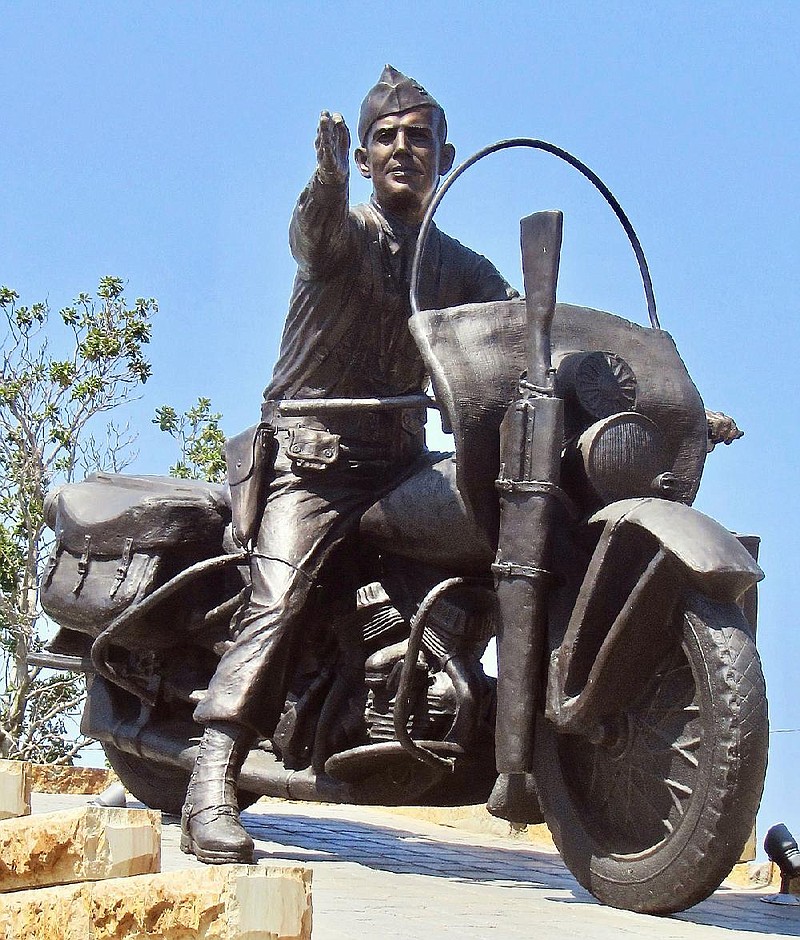FORT SMITH -- Few hometowns have a local hero as worthy of adulation as Gen. William O. Darby, whose bronze sculpture now occupies a place of pride in downtown Fort Smith.
Dedicated in 2016, 71 years to the day since he was killed by a German artillery shell in northern Italy, the statue in Cisterna Plaza by Little Rock sculptor Kevin Kresse depicts Darby astride a Harley-Davidson MLA motorcycle designed for military use. The monument's plaque sums up his place in history:
"William Orlando Darby (1911-1945) was the original commander of the U.S. Army Rangers, an elite force patterned after and trained by the legendary British commandos. Darby's Rangers were the first American troops to actively engage the German army in combat, at a desperate time when America had few resources to counter Nazi aggression in Europe.
"Spearheading amphibious invasions in North Africa, Sicily and Italy, Darby's Rangers quickly established themselves as a premier fighting unit whose methods became the cornerstone of today's specialized infantry formations. General Darby's command was unique in that officers and men trained, fought and died together. The original 500 Rangers suffered a 90 percent casualty rate.
"General William Orlando Darby was killed in his customary place, the front of his command, just days before World War II ended in Europe. His courage and sacrifice will always be remembered."
If a Harley-Davidson sounds like an odd mode of transport for a combat commander, an explanation can be had at Fort Smith Museum of History, where the Gen. William O. Darby Memorial Room tells the story of his life.
It seems that Darby preferred a motorcycle to the normal officer's conveyance in a jeep when traveling near the front lines. In the museum, a wall-size enlargement of a Newsweek magazine cover from 1943 shows him in sunglasses sitting on a Harley-Davidson while posing with two Free French officers in North Africa.
Updated two years ago, the Darby gallery offers a cellphone audio tour with commentary by two of his nephews. Visitors can find out that his boyhood home at 311 General Darby St. contains personal memorabilia and is sometimes open to the public.
There also is a Darby Junior High School in Fort Smith. An Army troopship carries his name. Warner Bros. made a 1958 film, Darby's Rangers, starring James Garner. Cisterna Plaza, location of the Fort Smith statue, is named for the sister-city Italian community near which his Rangers fought a bloody engagement.
In a school essay, Darby once wrote that he would be either "something great" or a "professional bum." After graduating from Fort Smith Senior High in 1929, he garnered an appointment to the United States Military Academy at West Point, N.Y. After graduation and a number of military postings, he deployed to the British Isles at the outset of 1942 and was chosen to lead the Army's first elite commando unit.
After commanding his men in North Africa and Italy, he was ordered back to the United States in 1944 for office duty at the Pentagon. Eager to return to action, he got assigned as a full colonel in early 1945 to an inspection tour of European battlefronts.
When the assistant commander of the 10th Mountain Division was wounded, Darby volunteered to take his place. As the Encyclopedia of Arkansas History & Culture reports: "On April 30, 1945, he was in the process of outlining plans for the next day when a German shell exploded near his location. A piece of shrapnel hit him, and he was dead within minutes."
Two weeks later, he was posthumously promoted to brigadier general, America's only World War II officer to receive such an honor after death. His decorations included two Distinguished Service Crosses, second highest Army award after the Medal of Honor.
As a museum information panel notes, his body was returned from a military cemetery in Italy in 1949. He was reburied at Fort Smith National Cemetery, not far from his boyhood home.
Fort Smith Museum of History, 320 Rogers Ave., is open 10 a.m.-5 p.m. Tuesday-Saturday (also 1-5 p.m. Sunday through August). Admission to the museum is $7 for visitors 16 and older, $2 for youngsters 6 to 15, free for those 5 and under. Military members and veterans pay $5. For details, visit fortsmithmuseum.org or call (479) 783-7841.
Style on 07/31/2018
